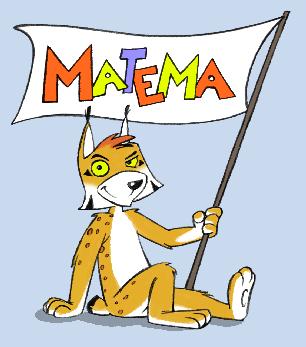Matthias Ehrhardt
Die Mathematik von Weltrekorden
Können Exponentialfunktionen Sportrekorde vorhersagen?

Das MATEMA-Logo (ein Luchs, copyright by Ulf Grenzer)
Beschreibung
Wir wollen in diesem Vortrag untersuchen, inwieweit man das olympische Motto von "höher, schneller, weiter"
mathematisch modellieren kann.
Wir werden die Entwicklung der Sportrekorde anhand der Beispiele
(100m Männer, Marathon Männer, 50km Gehen Männer, sowie 400m Freistil Schwimmen Frauen)
der vergangenen Jahrzehnte untersuchen
und den Verlauf mit einer (stückweisen) Exponentialfunktion annähern:
dies erlaubt uns eine (gewagte?) Voraussagemöglichkeit, wann welche neuen Rekorde aufgestellt werden
und wo der absolute Limit liegt.

Das MATEMA-Logo (ein Luchs, copyright by Ulf Grenzer)
Referenzen für den Vortrag
- G. Berthelot, V. Thibault, M. Tafflet, S. Escolano, N. El Helou, et al.,
The Citius End: World Records Progression Announces the Completion of a Brief Ultra-Physiological Quest,
PLoS ONE 3 (2008), e1552.
- H. Dambeck,
Mathematik und Sportrekorde - Das aussichtslose Ringen mit der Exponentialfunktion,
Numerator, Spiegel Online 10.2.2008
- K. Levenberg, A Method for the solution of certain problems in least squares,
Q. Appl. Math. 2 (1944), 164-168.
- D. Marquardt, An algorithm for least-squares estimation of nonlinear parameters.,
SIAM J. Appl. Math. 11 (1963), 431-441.
- A.M. Nevill und G.P. Whyte, Are there limits to running World Records?,
Med. Sci. Sports Exerc. 37 (2005), 1785-1788.
- A.M. Nevill, G.P. Whyte, R.L. Holder und M. Peyrebrune,
Are there limits to swimming World Records?, Int. J. Sports Med. 28 (2007), 1-6.
- K. Norton und T. Olds, Morphological evolution of athletes over the 20th century: causes and consequences,
Sports Med. 31 (2001), 763-783.
- W. Reinboud, Linear models can't keep up with sport gender gap, Nature 147 (2004), 432.
- A.J. Tatem, C.A. Guerra, P.M. Atkinson und S.I. Hay,
Momentous sprint at the 2156 Olympics ?, Nature 431 (2004), 525.
- D.E. Warburton, C.W. Nicol und S.S. Bredin, Health benefits of physical activity: the evidence,
Can. Med. Assoc. J. 174 (2006), 801-809.
- B.J. Whipp und S. Ward, Will women soon outrun men?, Nature 25 (1992), 355.





